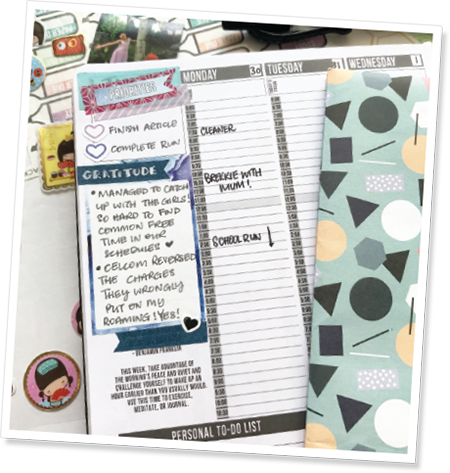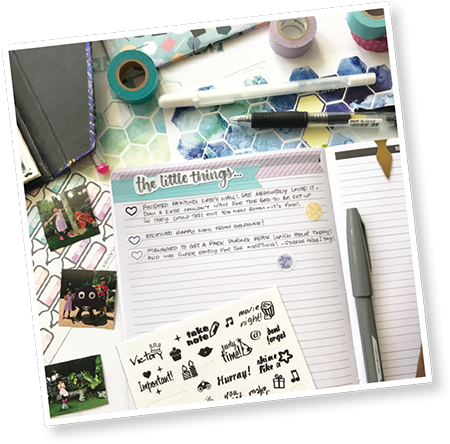 A few months ago, I touched on the different kinds of journals you could utilize and how many of them can be combined to suit your lifestyle and needs. Amongst the many you could immerse yourself in, one simple form stands out as having the most impressive impact on one’s social, psychological and physical well-being – the gratitude journal.
A few months ago, I touched on the different kinds of journals you could utilize and how many of them can be combined to suit your lifestyle and needs. Amongst the many you could immerse yourself in, one simple form stands out as having the most impressive impact on one’s social, psychological and physical well-being – the gratitude journal.
Over the years, studies have shown that the practice of writing down the things we are thankful for, even just a few times a week, leads to improved sleep quality, milder symptoms when ill, less stress, and generally, a happier, calmer outlook. It not only boosts self-esteem, but fosters mental strength and resilience as well. By making it a point to reflect on our experiences and identifying the good stuff, we become more aware of them as we go through our day, bringing about immediate positive emotions and reducing a multitude of toxic ones.
I liken it to buying a car, driving it around the first few weeks and noticing that suddenly, lots more people are driving the exact same car. The truth is most likely that the cars were there all along, but only came into conscious view because we were enjoying our own new car.
Gratitude journaling, on the surface, is easy and pretty straightforward. Apart from stand-alone gratitude journals, this wonderful practice can be effortlessly incorporated into the weekly spreads of your planner or as journal entries dedicated to giving thanks in your personal journal. It takes only 10 to 15 minutes of your time and works wonders instantly. To ensure you reap the most rewards from your gratitude exercises, keep these 6 points in mind.

1) Choose Happiness
Changing habits come with its fair share of challenges. There will be days harder than others to find the silver lining, and days where a myriad of other more interesting activities take precedence over sitting with your journal. Happiness isn’t merely a result of having things. It is the result of being grateful we have them in the first place. Gratitude breeds happiness, and cultivating gratitude takes practice, which is exactly what gratitude journaling is for. Make happiness your biggest motivator, keep at it and you’ll be able to identify the positives when you need them the most.
2) Drill down
The effectiveness of this practice lies in its ability to gradually change the way we perceive situations and adjusting what we choose to focus on. Write not only WHAT it was that delighted you, but also WHY you felt so positively about it. Elaborate on your points and be as specific as possible in your entries. Instead of writing “I’m grateful for my husband”, it is way more meaningful to write “I’m grateful for my husband because he took the car for a service today even though it would be out of his way”.
3) Appreciate people
Our relationships with people greatly determine the level of happiness we feel in our lives. Making a conscious effort to notice the people we are thankful for, rather than just circumstances or material things, and acknowledging them by putting it down on paper is a sure way to enhance the benefits gained from giving thanks.
TIP: Take it a step further and extend your gratitude beyond the pages of your journal! A simple thank you note is a personal and understated approach to expressing how someone lifted your spirits. Let others know how appreciated they are and find out exactly how contagious happiness can be!
4) Freshen it up
With many of us, the motivation to become happier is enough to start us off on our little gratitude journey and our pages start to get filled with entries resembling “Mum bought my favourite mangoes!” and “Long weekend and a much-needed break! Woo!!” However, things can get pretty mundane, not to mention demotivating, if we were to write about the same things each time. To maintain a successful gratitude practice, challenge yourself to seek out and identify new things you are grateful for, never repeating the same entries. I can still be grateful for my husband, but this time, it can be because he bought dinner home on his way back from work.
5) Surprise!
A good way to make your gratitude journal more meaningful is to pay special attention to the unexpected events or surprises that made your day that much brighter. These types of events tend to elicit stronger feelings of gratitude and happiness, so savor every bit of the surprise and document them in vivid detail.
6) Good vibes only
While we tend to pour our hearts out into our personal journals, reserve your gratitude journal for only the positive, uplifting parts of your life. It is during the hardest of days that working on your gratitude becomes so much more impactful. Take the time our house was broken into by a petty thief. I had been working on my laptop into the wee hours of the morning and had left it on the couch to charge. When I woke up 3 hours later, the front door was wide open and my laptop, along with all the data I had been working on the past month was no more. Imagine my devastation when I realized I would have to start all over again from scratch, point zero. After a good 10 minutes of complaining, sitting on the stairs bawling my eyes out and feeling sorry for myself, one singular thought entered my mind ~ Thank goodness my laptop was there for the thief to steal, for if he had come in and found nothing, the worst case scenario would be him coming upstairs to demand our belongings personally. Thank goodness he ONLY took the laptop. Within seconds, my outlook on the situation shifted completely to one of gratitude and I was able to move on.
We aren’t able to control exactly what happens to us, but we can definitely control how we react to our circumstances. Gratitude is an emotion that needs to be fostered consistently for it to be second nature. Look to your gratitude journal as an instant pick-me-up in times when you are feeling low to remind yourself of all the things you have going for you. See for yourself how quickly a bad day isn’t so bad after all… and be happy!
www.instagram.com/artsunami
www.facebook.com/artsunami

























